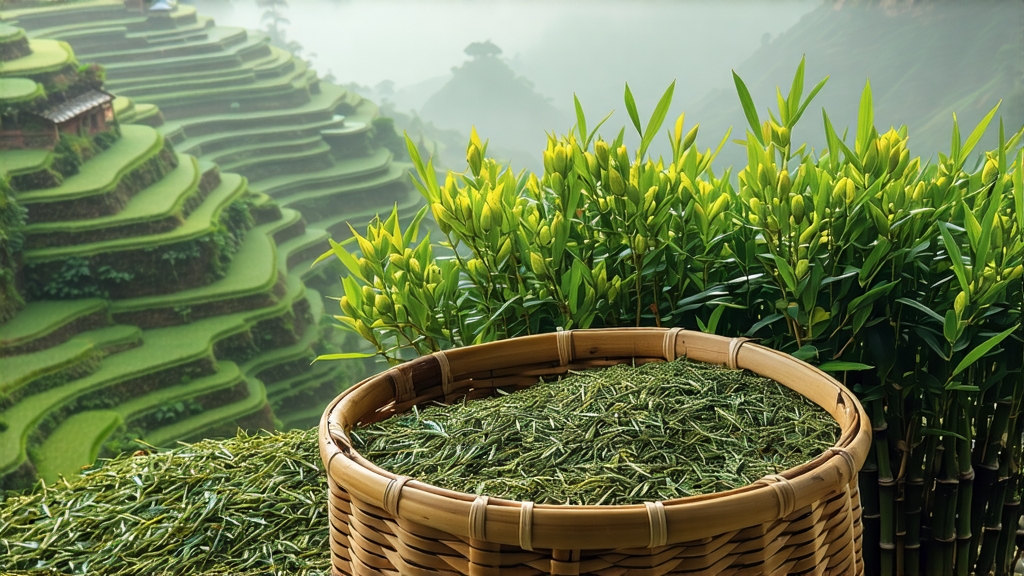
High on the mist-laced shoulders of Mt. Meng in Sichuan province, where clouds brush evergreen camellia canopies at 1,400 m, one of China’s most discreet tea treasures is coaxed into being. Meng Ding Huang Ya—literally “Meng Summit Yellow Bud”—is the oldest documented yellow tea, a style so labor-intensive that fewer than 3,000 kg reach the market each spring. To international drinkers accustomed to green flashiness or pu-erh theatrics, this tea offers a quieter revelation: a liquor the color of early dawn, a scent of fresh chestnut and wild orchid, and a finish that lingers like mountain mist on the tongue.
History: from imperial altar to forgotten classic
The first written record appears in 808 CE, when Tang-dynasty tea commissioner Fan Zong wrote that “the yellow buds of Meng Summit are offered to the Ancestral Temple, their fragrance ascending like incense.” By the Song dynasty the tea had become tribute, carried 1,500 km by fast horse to Bianjing (modern Kaifeng) in sealed bamboo tubes lined with silkworm silk. When green tea fashions dominated the Ming and Qing courts, Meng Ding Huang Ya slipped into obscurity; locals still picked the buds but simplified the craft, letting the yellowing step vanish. It was not until 1959 that agronomists at the Sichuan Tea Research Institute recovered the full protocol from a 1542 manuscript, reviving the variety in time for National Day celebrations. Today the tea is protected under China’s Geographic Indication scheme, and the 800-year-old Buddhist monastery on the summit still dedicates the first kilogram of each harvest to the “Tea Sage” altar of Lu Yu.
Micro-terroir: why the mountain makes yellow
Mt. Meng blocks the cold Tibetan Plateau winds while catching the warm Sichuan Basin humidity. The result is 220 foggy days per year, a natural shade that slows photosynthesis and boosts amino acids—especially L-theanine, which gives Meng Ding Huang Ya its signature brothy sweetness. The soil is a crumbly quartz-rich yellow loam, slightly acidic (pH 5.2) and laced with selenium, an element that intensifies floral volatiles during the post-fermentation “sealed yellowing” phase. Growers insist that only the pre-Qingming buds—picked when the overnight temperature dips below 10 °C—contain the precise enzyme profile needed for the slow oxidation that follows.
Pluck standard: one bud, one leaf, 2.5 cm
Harvest begins at dawn on the 55th day after the spring equinox, when 60 % of the bushes show the “fish-leaf” stage: the tiny protective scale that clasps the bud. Teams of pickers, 70 % of them women who have climbed the mountain for three generations, snap the shoot above the second node. Leaves must be 2.0–2.5 cm long, the bud weighing 0.12–0.15 g; anything larger will not yellow evenly. Within ten minutes the harvest is slipped into bamboo baskets lined with fresh banana leaves to prevent compression bruising.
Craft: the art of “men huang” (sealed yellowing)
Yellow tea is often described as green tea with an extra, secret step. In Meng Ding Huang Ya that step is men huang, a controlled suffocation that lasts 72–96 hours and transforms chlorophyll into pheophytin, catechins into theaflavins, and grassy aromatics into chestnutty, orchid-like notes. The full sequence is:
- Sha-qing (kill-green): 160 °C for 3 min in a shallow 80 cm drum, hand-tossed to keep buds intact.
- Re-wrap rolling: while still 50 °C, the leaf is rolled for 8 min under a hemp cloth to rupture 30 % of cell walls—less than green tea, preserving inner juices for yellowing.
- First drying: 70 °C basket firing reduces moisture to 20 %.
- Sealed yellowing: the semi-dry leaf is piled 8 cm deep inside oak boxes lined with wet cotton; temperature is held at 32 °C and humidity 78 %. Every 6 h the pile is gently turned; oxidation heat is vented, but oxygen is kept low. The leaf slowly turns sulfur-yellow from the edge inward.
- Final firing: 60 °C for 90 min, then a